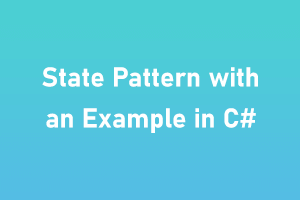The State pattern provides a way to encapsulate the behavior of an object into separate state classes. Each state class represents a different behavior of the object based on its internal state. By using the State pattern, you can eliminate long and complex conditional statements that check the object’s state, making the code more maintainable and flexible.
In the State pattern, the object delegates the behavior that varies with the state to a separate object representing each state. The object’s behavior changes dynamically as it transitions from one state to another.
Here’s an example of how the State pattern can be implemented in C#:
// Define the State interface
public interface IState
{
void Handle(Context context);
}
// Define the ConcreteState classes
public class ConcreteStateA: IState
{
public void Handle(Context context)
{
// Behavior for state A
// Transition to a new state if necessary
context.State = new ConcreteStateB();
}
}
public class ConcreteStateB : IState
{
public void Handle(Context context)
{
// Behavior for state B
// Transition to a new state if necessary
context.State = new ConcreteStateA();
}
}
// Define the Context class
public class Context
{
private IState _state;
public Context(IState state)
{
_state = state;
}
public IState State
{
get { return _state; }
set { _state = value; }
}
public void Request()
{
_state.Handle(this);
}
}
// Client code
var context = new Context(new ConcreteStateA());
context.Request(); // Behaves according to ConcreteStateA
context.Request(); // Behaves according to ConcreteStateB
context.Request(); // Behaves according to ConcreteStateA again
In this example, the State pattern is used to manage the behavior of the Context object. The Context object can have different states, represented by the IState interface and its concrete implementations, such as ConcreteStateA and ConcreteStateB. Each state is responsible for handling the Context object differently, and it can change the state of the Context object dynamically by setting its State property.
The Context object has a Request() method that delegates the behavior to the current state, which handles it according to its own implementation. This allows the Context object to behave differently depending on its state, without having to use large conditional statements or switch statements to determine the appropriate behavior.
StudySection gives an opportunity to beginners and experts in .NET framework to go through StudySection’s .NET Certification Exam and get a .NET certification for enhancement of career in programming. If you have knowledge of the .NET framework then you can get a certificate through an online exam at StudySection.




